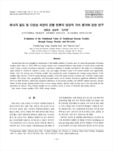

PARTNER
검증된 파트너 제휴사 자료
에너지 밀도 및 다양성 측면의 전통 면류의 영양적 가치 평가에 관한 연구
방대한 850만건의 자료 중 주제별로 만들수 있는 최적의 산출물을 해피 캠퍼스에서 체험 하세요 전문가의 지식과 인사이트를 활용하여 쉽고 폭넓게 이해하고 적용할수 있는 기회를 놓치지 마세요
10 페이지
최초등록일 2016.04.02
최종저작일
2014.08

-
 * 본 문서는 배포용으로 복사 및 편집이 불가합니다.
* 본 문서는 배포용으로 복사 및 편집이 불가합니다.
미리보기
서지정보
· 발행기관 : 한국식품영양학회
· 수록지 정보 : 한국식품영양학회지 / 27권 / 4호
· 저자명 : 양윤경, 김성옥, 김주현
목차
Abstract
서 론
연구방법
1. 재료의 분량, 첨가 재료의 건강․기능성을 평가
2. 통계분석
결과 및 고찰
1. 전통 면류의 구분 및 분포
2. 에너지 밀도에 의한 평가
3. 면류의 % daily value
4. 면류의 에너지 섭취비율, 동․식물성 섭취 양상, 기능성 성분 함량 비교
5. 섭취 식품의 다양성(Dietary variety score 및 Dietary diversity score) 조사
요약 및 결론
감사의 글
References영어초록
Korean foods have the strengths to addresssome of the health problems of modern man. To assess the properties of Korean noodles, daily value %, DVS, DDS and energy density were compared between many kinds of noodles from around the world. Using a variety of reference materials, a nutritional database of noodles was built for this study. For carbohydrate, lipid, vitamin A, vitamin K, vitamin C, niacin, zinc, and copper, the daily values % of western noodles were significantly higher. Also, the serving size of Korean noodles was significantly small. Comparing the average energy density of the noodles, they showed 1.87±0.93 kcal/g (Korean noodles), 2.42±1.08 kcal/g (western noodles) and 1.84±0.84 kcal/g (other noodles). The dietary fiber, polyphenols, and flavonoids content of the noodles showed no significant difference. Neither DVS nor DDS showed a statistically significant difference. In the Korean noodles, the GMDFV pattern showed a diverse choice of food groups. Korean noodles show a lower energy density, and the small serving size to have favorable for the prevention of obesity. Thus, Korean noodles are an excellent choice in terms of diversity and energy density.참고자료
· 없음태그
-
자료후기
-
자주묻는질문의 답변을 확인해 주세요

꼭 알아주세요
-
본 학술논문은 (주)코리아스칼라와 각 학회간에 저작권계약이 체결된 것으로 AgentSoft가 제공 하고 있습니다.
본 저작물을 불법적으로 이용시는 법적인 제재가 가해질 수 있습니다. -
해피캠퍼스는 구매자와 판매자 모두가 만족하는 서비스가 되도록 노력하고 있으며, 아래의 4가지 자료환불 조건을 꼭 확인해주시기 바랍니다.
파일오류 중복자료 저작권 없음 설명과 실제 내용 불일치 파일의 다운로드가 제대로 되지 않거나 파일형식에 맞는 프로그램으로 정상 작동하지 않는 경우 다른 자료와 70% 이상 내용이 일치하는 경우 (중복임을 확인할 수 있는 근거 필요함) 인터넷의 다른 사이트, 연구기관, 학교, 서적 등의 자료를 도용한 경우 자료의 설명과 실제 자료의 내용이 일치하지 않는 경우
“한국식품영양학회지”의 다른 논문도 확인해 보세요!
-
콩 품종별 발효기간에 따른 청국장의 이화학적 특성 9 페이지
-
후코이단에 의한 니코틴의 코티닌 전환 효과 7 페이지
본 연구에서는 nicotine 분해에 효과에 대하여 해양식물 유래의 후코이단을 이용하여 시험관에서 직접 혼합법 및 세포주 시험에서 nicotine의 cotinine으로의 전환능을 측정하였다. 직접 혼합법 시험결과, 후코이단 1 μg/mL에서 시간이 경과함에 따라서 nicotine의 cotinine으로의 전환 정도가 대조군 대비 증가하여 시험 종료 시점에서 .. -
미국 버지니아주 거주 한국인과 미국인의 건강상태 인식도 및 짠맛 기호도 비교 9 페이지
-
올리브 오일을 첨가한 어육 소시지의 최적화 연구 10 페이지
-
곤약 가공을 위한 응고제 선정 및 식중독균에 대한 항균 활성 확인 7 페이지
본 연구에서는 곤약 가공을 위한 응고제와 침지액을 선정하고, 침지액 농도에 따른 식중독균에 대한 항균 활성을 확인하였다. 응고제 종류에 따른 곤약의 응고시간별 물성 변화는 응고액의 종류에 관계없이 응고시간이 진행될수록 경도, 검성 및 씹힘성이 증가하였다. 응고제 종류에 따른 곤약의 무기질 함량은 응고제가 Ca(OH)2일 경우, NaOH를 이용한 곤약보다 유..
문서 초안을 생성해주는 EasyAI
